[ad_1]
Written by Ari Gautier, Ananya Jahanara Kabir | Manchester, Oslo |
Updated: April 24, 2021 6:52:48 pm
When the Portuguese explorer Vasco Da Gama disembarked near Calicut in 1498, he inaugurated a new phase in history. The sea routes were opened up, and the Dutch, French, Danes, and British soon followed. The coastal enclaves they founded became hubs of cultural exchange. Their economic potential attracted many kinds of people, including merchant communities, from outside and within India. ‘Creolisation’ resulted. New, unexpected cultural products sprang up from this interaction between different languages, different gods, different ways of living, and different ways of cooking and preparing food.
What was cooking in creole India’s kucinis?
Kucini Tales is a five-part flash fiction series, based on research on creolised food histories of India: the results of cultural encounters within settlements on the Malabar, Konkan, and Coromandel coasts and Bengal’s Hooghly district, founded and fought over by the Portuguese, Dutch, French, Danish, and British. Communities remember memorable events through scenarios that repeat as dramatic stories or myths. Our kucini tales are mini-scenarios, that entertain you with food stories from Creole India.
The first story was about vinegar as generator of creole connections. It introduced Jean-Foutre Kaattumottar and Vattalakundu Rani. The second tale presented Sebastião Gonçalves Tibau and Bibi Juliana Firangi competing for the best creole dishes. In Kucini Tale 3, Sangli Kalpou, Tamil diasporic deity, and his beloved Mohini befriend Kappiri Muthappan, the leader of African spirits of Fort Kochi, and the mermaid Kadal Kanni, to reveal the transoceanic secret of the iconic kerala dish ‘puttu’. In this fourth story, we shine the spotlight on the iconic Bengali dish, potoler dolma and its Armenian connections. Get to the heart of the matter with Armenian singing star Gauhar Jan and the mysterious Oumalakkan Tattankuchi from Pondicherry at a Calcutta soirée where keema stuffing meets a variety of Indic gourds…
Creolisation is about mixing up words, ingredients and techniques, so we invite you to savour new words you might encounter as you read, play guessing games with them, and find connections with words you know (‘Kucini’ is the Pondicherry Tamil word for ‘kitchen’, which comes from Portuguese ‘cozinha’ or ‘kitchen’).
At the end of each story, you will find: a glossary, an ‘axiom’ of creolisation, and a summary of the underlying historical and cultural facts.
Uff! Patol i pous tort sé lerk lé tann i fo drésé! If you don’t tend to it, the potol will surely turn out crooked! The Reunion kreyol proverb flashed into Sangli Kalpou’s mind as he was jostled by the urchins crowding the lane. Striding ashore after mooring his kattumaram at Calcutta’s Nimtala Ghat, his confidence had rapidly given way to disorientation. What a vast and crowded city! His sole reference point was 24 Chitpur Road. There his seafaring buddy Chinali Bartholomé worked as bawarchi for an Armenian singer and dancer who had made it big in the entertainment business. Ah! Here it was! Sangli Kalpou looked up at the imposing edifice. Corinthian pillars held up a portico with a first-floor balcony. Green shuttered windows radiated from either side. And on the balcony, Chinali himself, with Gauhar Jan!
‘Yes Gauhar Beebeh, it’s all ready for the party, the fish paste and the hollowed gourds. At Peribeebeh’s, I’ll pop into the kitchen to stuff the gourds and make the inchimintu curry.’
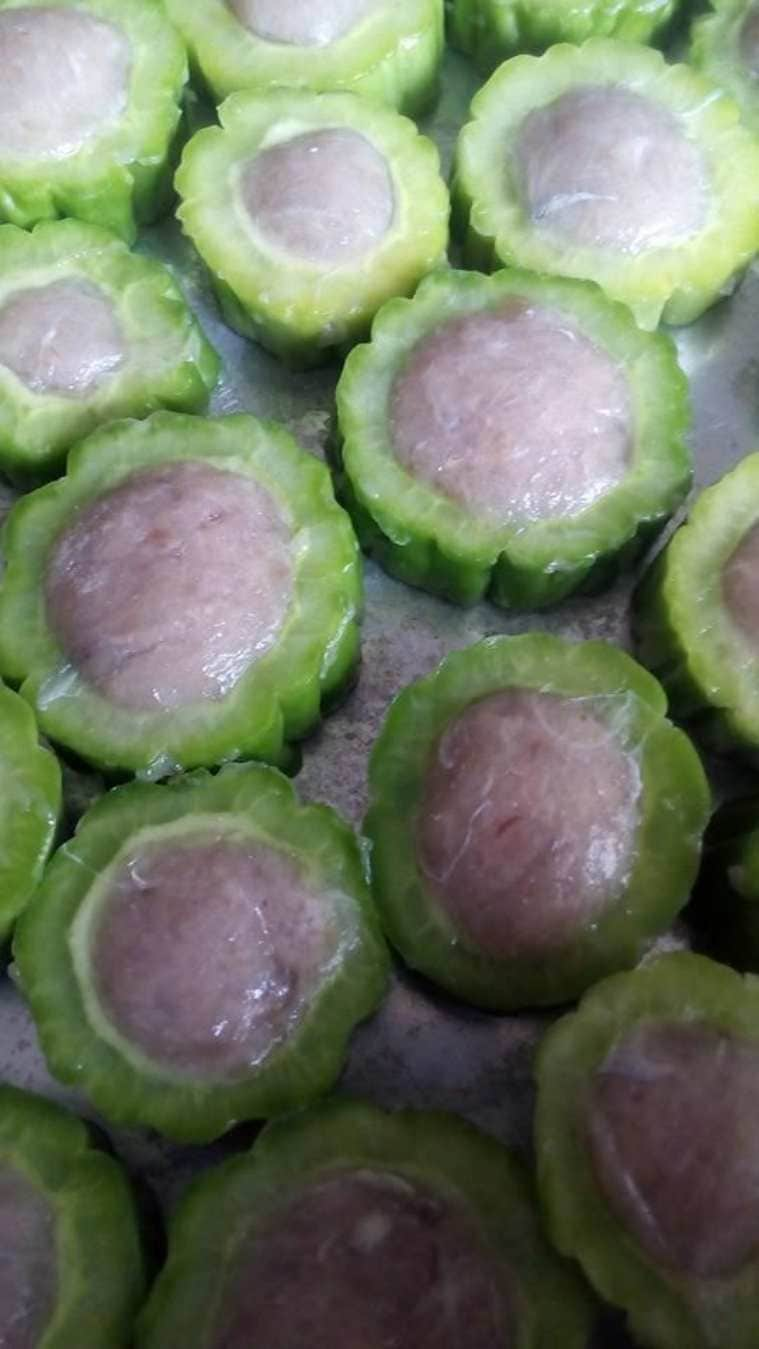 Inchimintu preparation ( Photo credit: Maureen de Mello)
Inchimintu preparation ( Photo credit: Maureen de Mello)
‘Well– I hope Peribeebeh’s cook Belat Mia will allow you!’ Gauhar Jan’s voice was crystal-clear, with a hint of flirtatiousness. ‘He’s so competitive!’
‘Gauhar Beebeh, don’t worry. We are old friends from sea’, he heard Chinali reply.
‘I hope so, Chinali,’ responded Gauhar Jan. ‘ I’m bored of cabbage dolmas! Want your inchimintu!’
‘Enough evesdropping!’ Sangli Kalpou told himself. ‘Time to catch Chinali’s attention!’
‘What a story!’ As their ghoda gari clattered down Central Avenue, Gauhar Jan listened, fascinated, as Sangli Kalpou revealed the reason behind his perilous sea-journey to Calcutta from the Indian Ocean island of Reunion. He used to be the Tamil village deity Sanguili Karuppu, he explained. On crossing the kala pani with indentured labourers to Reunion, he had transformed into Sangli Kalpou. Some time ago, he had received a message in a dream from a mysterious divinity, Dih Baba of Calcutta. Neglected by his followers who worshipped new gods from elsewhere, Dih Baba wanted to go into exile. He had heard of an island where people were migrating in droves. Sangli Kalpou was delighted. He was being overwhelmed by the indentured labourers disembarking every day at Reunion and its neighbouring island of Mauritius. He couldn’t satisfy everyone! He would send Dih Baba to Mauritius, and himself focus on Reunion. But the only person he knew in Calcutta was Chinali. So here he was.
‘We’ll find him for you,’ declared Chinali as he manoeuvred the horse-drawn carriage. Sangli Kalpou shot him admiring glances. The last time they had seen each other was at Kochi, while Chinali was moving from Goa to Bengal. Whether a boat, a carriage, or a vaanal, the man could adapt to anything!
‘But enjoy dinner first— Peribeebeh’s gatherings are legendary. And don’t miss the sights. You’re in the grandest city of the world.’ The carriage was moving down Brabourne Road. ‘There’s Nakhoda Masjid, that’s the mosque for us lascar types! And the Armenian Church and Jewish Synagogue ahead. The Chinese market is here…’ Sangli Kalpou was agape at this architectural and confessional variety.
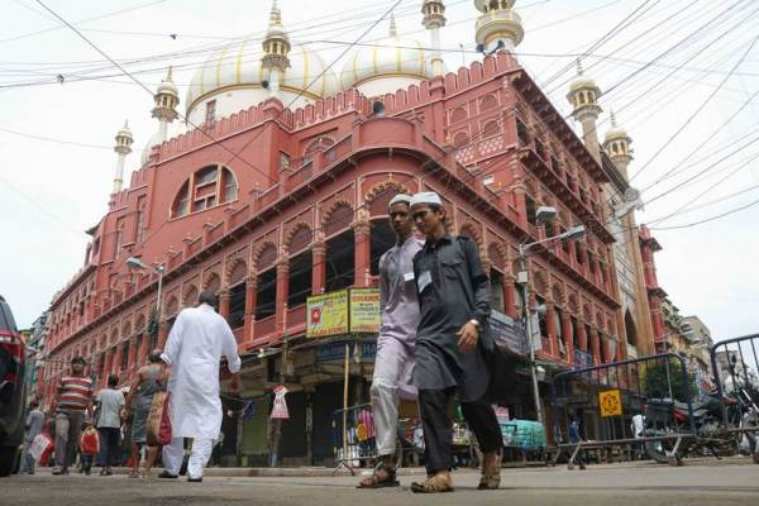 The Nakhoda Masjid (Express photo by Shashi Ghosh)
The Nakhoda Masjid (Express photo by Shashi Ghosh)
The carriage stopped in Armenian Street and the threesome got out. What a group! Who could pin down their race or ethnicity? But in Creole Calcutta, no one cared. Jews, Armenians, Bohras, Chinese, Eurasians, Parsis, Marwaris, Biharis… all here to make a fast buck from the Empire, speaking in the kalkatiya bazaar tongue, singing each other’s songs, enjoying each other’s food… Sangli Kalpou was loving the vibe. And Gauhar Jan with her fancy Persian name and clothes! Velveteen overcoat with gold edging and fringed trousers; Basra pearls; high-heeled memsahib shoes; uncovered head; direct gaze; cherry-coloured lips: What style!
Their host Peribeebeh was equally superbly attired. ‘These are Calcutta’s Armenian ladies,’ said Chinali to Sangli Kalpou, ‘but they might as well call themselves Eurasian, or Jewish—in this Grey Town, women can be anything. Money, song, and a good party is all that people want!’ He disappeared into the kitchen with Peribeebeh’s fabled Muslim cook, Belat Mia.
In the opulent drawing-room, chairs, chaises longues and small tables dotted the marble floor. Punkahs swished, chandeliers and Belgian glass mirrors glittered. Gauhar Jan was enthralling the guests. Stepping to waltz timing, she sang a thumri in Bhairavi. ‘My name is Gauhar Jan!’ she ended with her trademark flourish.
The entire audience rose up clapping with delight—except for one person. Gauhar Jan, used to indiscriminate adulation, was struck by this reticent young man of refined bearing. She looked at him quizzically. Who was he? Busy chatting to his neighbour who looked rather Turkish, he didn’t return her inquisitive glances. What insolence! Ignoring her, Gauhar Jan! Pretty annoyed, she turned to Peribeebeh and was about to address her, when Chinali’s voice rang out.
‘Inchimintu!’
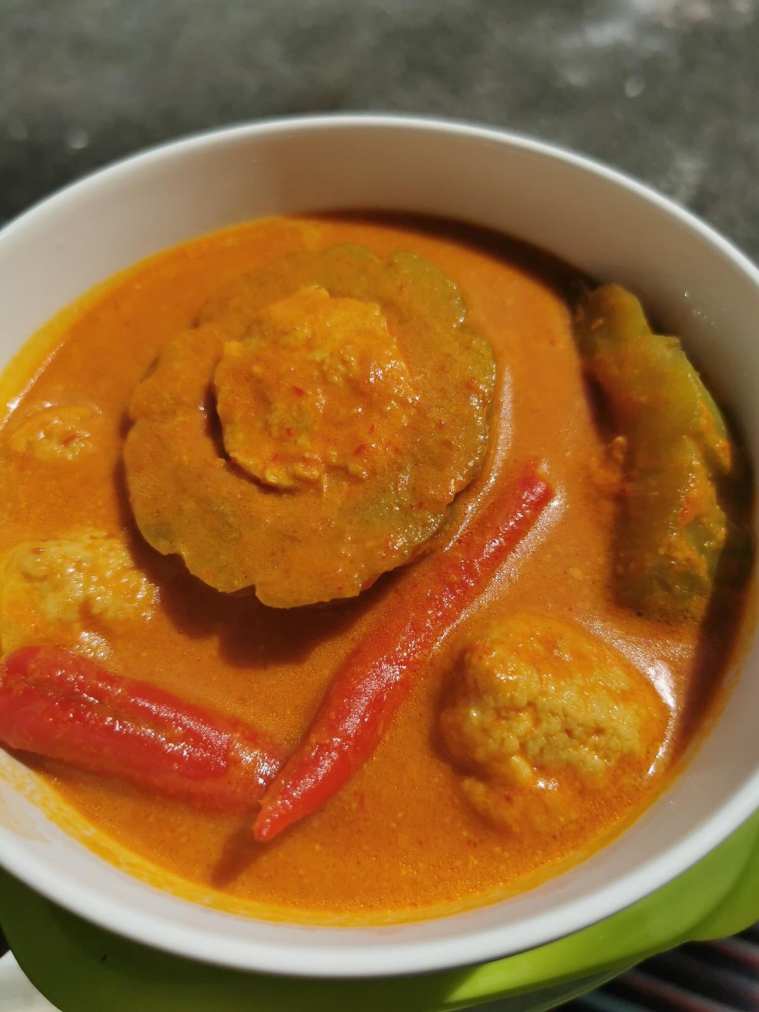 Inchimintu (Photo credit: Recipes Encyclopaedia)
Inchimintu (Photo credit: Recipes Encyclopaedia)
In a gleaming silver dish, on a bed of unctuous gravy, lay rings of bitter gourd stuffed with minced chital fish! Who would have imagined this combination? ‘It’s a Malaccan recipe from my homeland,’ said Chinali proudly. ‘Inchi is ‘to stuff’ in our language, and as for mintu— Senhor Oumalakkan Tattankutchi will recognise it as the -mento which ends almost every noun in Portuguese!’
Oumalakkan Tattankutchi? Gauhar Jan stifled a giggle. What kind of an outlandish name was that ? She shot him one of her famous looks, half-mocking, half-seductive. In truth, she was finding him more and more irresistible. There was something about his soft black eyes and elegant mien—she felt strongly she had met him somewhere, sometime…
Oumalakkan Tattankuchi’s attention was, however, totally on the inchimintu. ‘Yes of course, I know Portuguese,’ he said to Chinali. ‘But this dish…! korola with chital fish? Is this even possible? Korola is a penance and fish—well it’s an emotion!’ He gingerly tasted a piece.
The ladies fell about laughing. ‘Oumalakkan Tattankutchi, you may have come to Calcutta but recently, but you’ve become more Bangali than the locals!’ Peribeebeh declared.
Gauhar Jan’s curiosity was becoming unbearable. Though she wouldn’t admit it for all the world, she was dying to be introduced to him. Peribeebeh, who knew her friend only too well, savoured the moment. Best friends they may be, but a little rivalry could not help exist between these Armenian dazzlers !
‘Peri! Oumalakkan Tattankutchi is right.’ Gauhar Jan threw caution to the winds. In jumping to the defence of the young man with the bizarre name, she was sending him a clear signal. ‘We’ve lived in Bengal long enough. Chital fish makes great muittha, but not inside bitter gourd!’
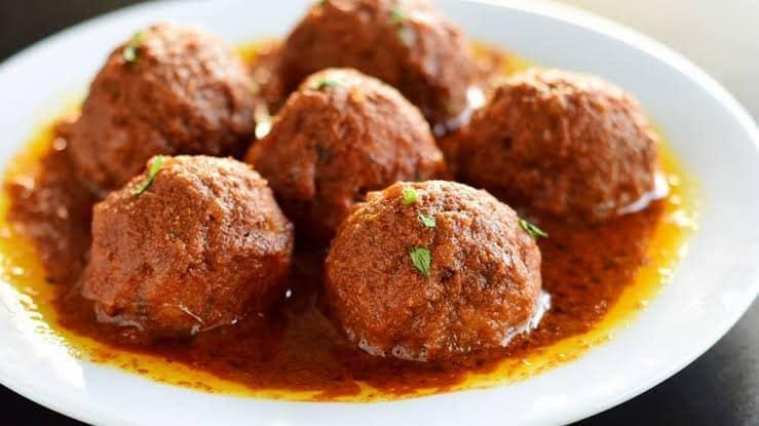 Chitoler muitha (Photo credit: Moumita Kar Roy)
Chitoler muitha (Photo credit: Moumita Kar Roy)
Gauhar Jan’s verdict bitterly disappointed Chinali. Fickle womankind! He cursed silently. Just a while ago she was praising his inchimintu to the skies! How his rival Belat Mia would relish his downfall!
‘Interesting how chital muitthas are basically chital koftas’, observed the Turkish-looking man next to Oumalakkan. ‘Must be the influence of the Chinese in Calcutta. The best koftas in Hindustan were fashioned from the qiyma that my ancestors brought here.’ This man was descended from his namesake, Malik Ayaz, Mameluke slave who had ended up Governor of Diu. An Orthodox Russian captured by the Turks and sold as a slave in Istanbul, Malik Ayaz had absorbed the culinary secrets of the Turks which he then carried to Diu. ‘And so qiyma, the Turkic art of chopping meat fine, became the keema of Hindustan, transforming Indo-Persian koftas made with pounded meat to new-style koftas fashioned from keema, and, eventually, dolmas…’
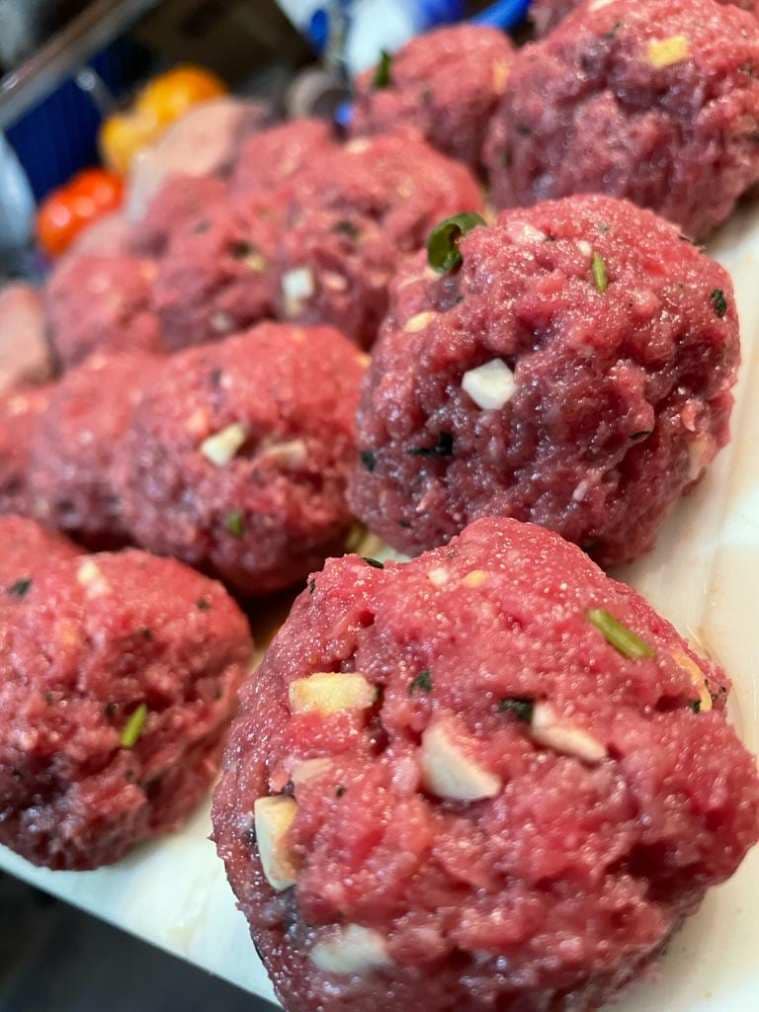 Koftas fashioned out of beef quima. (Photo credit: Suda Cuisine)
Koftas fashioned out of beef quima. (Photo credit: Suda Cuisine)
‘Malik Ayaz!’ Gauhar Jan interrupted. ‘keema I’ll leave to the Turks, but it was the Armenians—my ancestors—who brought dolma here.’
‘Gauhar Jan,’ said Malik Ayaz feebly, ‘dolmak is Turkish for ‘to stuff’, just like inchi…’
‘Chhokra!’ thundered Peribeebeh. ‘Armenians have been everywhere! We’ve naturally picked up some Turkish words. We’ve been in Hindustan for centuries, too! Since the vine leaves used to make dolmas are so hard to get here, we’ve even begun using that helpful vegetable the Portuguese brought— cabbage.’
‘But that is the problem with our dolmas, Peri!’ Gauhar Jan intervened. ‘cabbage dolmas fall apart in a curry. All the keema stuffing escapes and gets mixed up with the gravy!’
‘So here’s the solution!’ An authoritative voice rang out. Belat Mia, Peribeebeh’s cook, had appeared from the kitchen. He held aloft another gleaming dish. Draped in the delicious tomato-onion gravy that Chinali had created for his inchimintu sat a clutch of glossy green… pointed gourds! A maddening aroma of spicy beef keema arose from them. ‘Potol?’ exclaimed Peribeebeh incredulously. ‘Belat Mia, what a stroke of genius!’
Belat Mia tugged modestly at his wispy moustache. ‘Beebeh, as I saw Chinali stuff his chital fish mixture into the hollowed bitter gourds for inchimintu, I had a brainwave! Why not use potol, another local gourd, for our keema-stuffed dolma? Nice and firm, won’t fall apart like cabbage, not bitter like korola!
Coincidentally, I bought a splendid batch in Tiretty Bazaar this morning. Using Chinali’s technique, I selected some medium-sized potols, cut off their blunt ends, and carefully scooped out the seeds, leaving nicely smoothed-out hollows. The beef keema from New Market that I had prepared for the Anglo-Indian Ball Curry you like so much, I stuffed into the potols. And to prevent the keema from escaping into the curry, I secured the tops with… these.’ He held aloft a thin and tapered little sliver of wood. ‘The wooden toothpicks that are all the rage!’
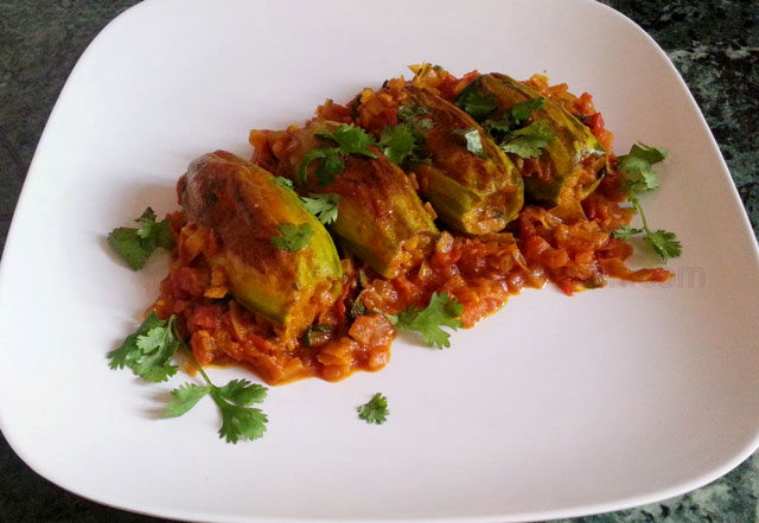 Potoler Dolma (Photo credit: Facebook)
Potoler Dolma (Photo credit: Facebook)
Chinali’s professional competitiveness gave way to undiluted admiration. He embraced Belat Mia: two athletes competing for gold. The latter was equally generous. ‘Chinali, if I hadn’t seen you prepare inchimintu I would have never hit upon this idea.’ Gauhar Jan clapped and sang in her beautiful voice to Bhairavi: ‘Potoler dolma!’
Sangli Kalpou, in the meanwhile, was mightily confused. ‘This is what you lot call potol? In Reunion, patol is a long and curvy gourd… it grows close to the ground and if unsupervised, can take crazy shapes… that’s why we have this kreyol proverb…’
‘But that’s what we call podolangai in Tamil! Snake gourd!’ butted in Oumalakkan Tattankutchi! ‘This great innovation you hail here… we’ve had our version for years. Podolangai farci! Curry of snake gourd stuffed with beef mince. What Pondicherry does today, Bengal does tomorrow!’
‘Ah yes, the great Pondicherrian pioneer Oumalakkan Tattankutchi!’ Said Malik Ayaz sarcastically. You’ve come to Calcutta looking for your father, why don’t you focus on your task?’
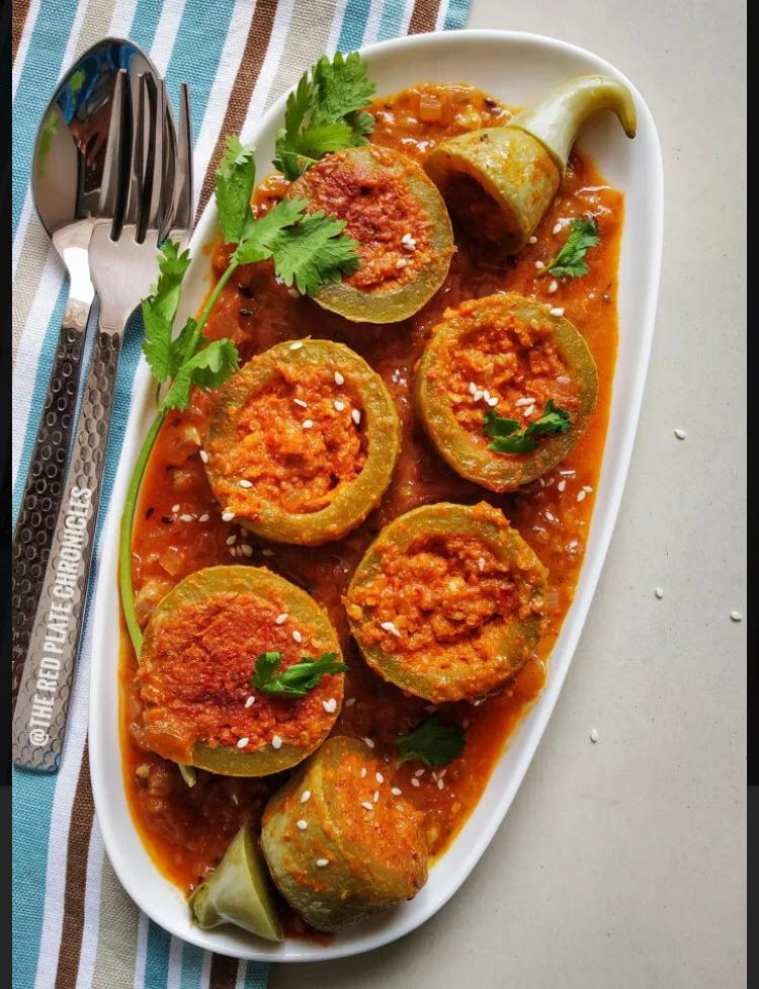 Stuffed snake gourd curry (Photo credit: Red Plate Chronicles)
Stuffed snake gourd curry (Photo credit: Red Plate Chronicles)
Gauhan Jan jumped up. ‘Are you from the Pondicherry Armenian community? Only Armenians make dolmas in India! But with your odd name…?’ Finally! She was going to get his story! Oumalakkan Tattankuchi did not disappoint.
‘My father is indeed from the community of Armenians, who have lived for centuries as merchants alongside Pondicherry’s Ariankupam River,’ he revealed. ‘But my mother was a Pondicherry Creole. My parents fell in love. Like in this Grey Town, different communities live close to each other in Pondicherry. Love and food flows between us like the Ariankupam or Hooghly. But marriage…! No. My grandfather sent my father off to Calcutta to separate my parents. I was brought up by the Pondicherry Creole community. Like the podolangai farci, I too am an Armenian product adopted by the Pondicherry Creoles! As for my name, it’s the same: sounds Tamil, but means nothing specific in Tamil. I came to Calcutta to find my Armenian father, but who knows what my identity is!’
‘But that’s what Pondicherry and Calcutta are, no?’ Peribeebeh soothed her guest. ‘Look at all of us, all reinventions of the past. Just like this potoler dolma!’
‘And like the similarities between potoler dolma, podolangai farci and inchimintu, we are all similar!’ Chinali chimed in. ‘Shaped by ingenuity, curiosity, and experimentation! The desire to replicate something cherished, but the freedom to adapt to local circumstances! The Armenians are in Malacca too, who knows who influenced whom to create inchimintu!’
‘So Chinali!’ exclaimed Peribeebeh Jan. ‘We are all versions of stuffed gourds?!
‘What a marvel, Peribeebeh!’ said Chinali. ‘These humble gourds, elevated by stuffing, connect us from Malacca to India!’
‘Don’t forget us in the islands!’ reminded Sangli Kalpou. ‘We got a bit mixed up between potol and podolangai… but next door to Reunion in Mauritius, the Hakka Chinese make a version of inchimintu— yong foo gwa they call it.’
So many connections and lost threads and reunions! Sangli Kalpou is looking for Dih Baba. Oumalakkan is looking for his father. And two lovers in another life seem to have found each other again: just as keema and potol (and podolangai) found each other in dolma (and farci)!
Oumalakkan Tattankutchi and Gauhar Jan were looking at each other meaningfully. He had finally accepted the feeling inside him: yes, he too knew her from somewhere, sometime… At some point in the evening, two vials– of Murano glass and of porcelain from Jingdezhen– exchanged owners through the clasp of hands.
Fourth axiom of creolisation
Exotic tastes become modern as they travel across water
To creolize local things— that’s the heart of the matter
Historical note
We were inspired by Calcutta’s potoler dolma (stuffed bottle gourd), Pondicherry’s podulangai farci (stuffed snake gourd), and Melaka’s inchimintu (stuffed bitter gourd). In these three port cities, crossroads of trade and travel, people had the same brainwave: take a local gourd, hollow it out, stuff it with something delicious, and make a curry. The catalyst was the mobile and mercantile Armenian community.
Ottoman cuisine both developed the art of mincing meat (qiyma, which became keema in India) and the art of stuffing qiyma into a vegetable casing to make dolma, typically, grape vine leaves. Armenians made the dolma their own– pointing to their complicated association with the Ottoman empire, ending with a massacre and explusion between 1894-96 that is widely considered a genocide.
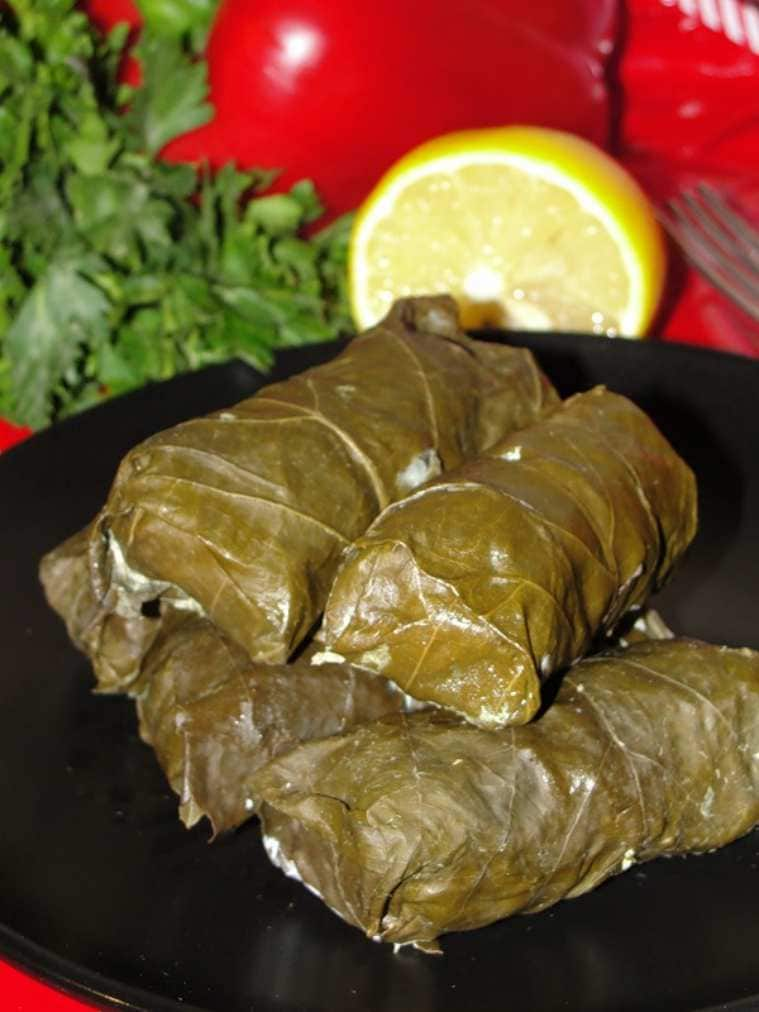 The Armenian Dolma (Photo credit: Wikimedia Commons)
The Armenian Dolma (Photo credit: Wikimedia Commons)
Armenians, present in India from Mughal times as merchants and cultural brokers, brought dolma to Calcutta. Keema entered Hindustan via other Turkic sources. Keema-stuffed gourd curries became classics of Indian creolised cuisine. In Melaka, the creolised/ Eurasian Kristang community created inchimintu, combining Chinese, Armenian, and Indic influences. Fish stuffed in bitter gourd (as in Chinese yong foo gwa, or stuffed bitter melon) would not have appealed to Indian tastes. But inchimintu displays the same idea as potoler dolma and podolangai farci: since vine leaves are not common in the Indian Ocean world, why not stuff one of the many gourds cultivated for over 10,000 years in Asia? And cook them in a spicy Indian-style gravy!
The hustle and bustle of 19th century ports, where communities and foodways mixed, stimulated people to experiment with typical dishes, tweak them with local foodstuffs, and spread these innovations. As local and global creolised, modernity emerges as a shared taste. Potoler dolma may have started as an Armenian innovation but other Calcutta communities adopted it. Muslim cooks (like Belat Mia), moving between Armenian, Anglo-Indian, Jewish and elite Muslim kitchens would have spread the technique. Hindu Bengalis replaced beef keema with mutton or fish (reinstating the parallel with inchimintu!) and even devised vegetarian stuffings with chhana (cottage cheese), echor (raw jackfruit), and mocha (banana flower), as the 1886 cookbook Pakpranali by Biprodas Mukherjee attests. (The chital fish used for the Bengali chitol machher muitta, or fish ball curry, never enters the potol as dolma stuffing).
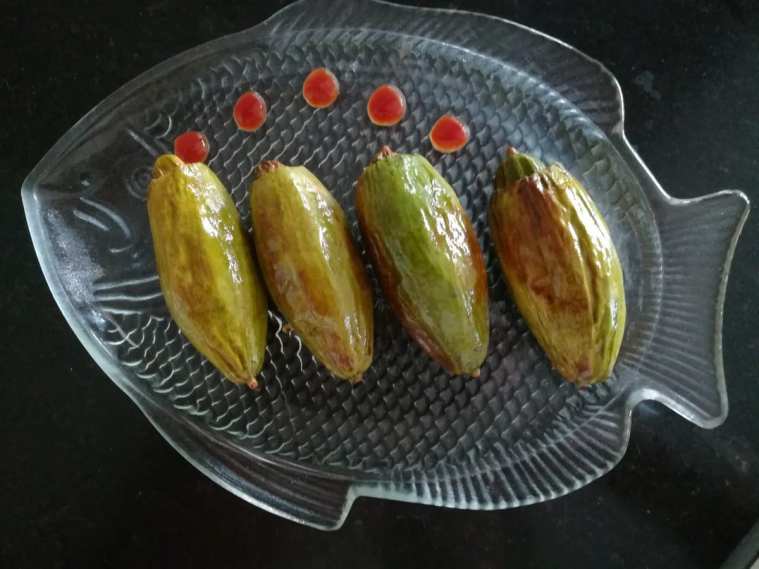 Potoler dolma may have started as an Armenian innovation but other Calcutta communities adopted it. (Photo credit: Wikimedia Commons)
Potoler dolma may have started as an Armenian innovation but other Calcutta communities adopted it. (Photo credit: Wikimedia Commons)
The creolised potoler dolma is part of a creolised modernity whose Calcutta epicentre was exactly that ‘Grey Town’ between Native and British segments described here. Even the toothpick, first mass-produced in the late 19th century, and still used to secure the dolma, is part of this modernity. And so is Gauhar Jan (26 June 1873 – 17 January 1930), the first Indian singer to be recorded, who always signed off by declaring in English, ‘I am Gauhar Jan’. Of Armenian and Anglo-Indian parentage, she lived in 24 Chitpur Road, Kolkata; ‘Peribeebeh’ riffs off ‘Rezabeebeh’, the first Armenian to be buried in Kolkata in 1630 (the community was established in Chinsurah before that); her party is modelled on soirées of the famous hostess of the Calcutta Jewish community, Minnie Curlendar.
 Gauhar Jan (Photo credit: Wikimedia Commons)
Gauhar Jan (Photo credit: Wikimedia Commons)
What these communities had in common was beef. The continuity between Armenians, Anglo-Indians, Jews, and other beef-eating groups are exactly paralleled in Pondicherry, where the podolangai farci emerged as a culinary parallel to the potoler dolma. Recipes for snake-gourd curry and for beef kofta curry (also called Ball or Boulettes curry) sit side by side in cookbooks of Anglo-Indian, Pondicherrian, and Calcutta cusines. We dramatise these parallels as affinities between creolised and creolising groups. And we send the Tamil diasporic deity Sangli Kalpou to Calcutta to remind readers of Indic culture’s further creolisations and transformations in the islands to which indentured labourers travelled.
We thank Sinjini Chatterjee, Coumar Ananda, and Suda Valmy for their contributions.
Glossary
Kattumaram: raft (Tamil; origin of the English word, ‘catamaran’).
Bawarchi: cook (Urdu/ Hindi; Bangla ‘baburchi’); the word uses Turkish suffix ‘-chi’
Inchimintu: bitter gourd rings stuffed with fish paste in a coconut milk gravy (Kristang, or Malaccan Portuguese Creole); the word combines Kristang verb ‘incheh’ (to stuff) the Portuguese-derived suffix ‘-mentu’. Other inchimintu preparations include inchimintu kangrezu (stuffed crab) and inchimintu kobi (stuffed cabbage).
Dolma: stuffed vine leaves from Turkish ‘dolmak’, to stuff; a
Ghoda gari: Horse-drawn carriage (Urdu/ Hindi/ Bangla)
Vaanal: frying pan (Tamil)
Punkah: fan (Hindi ‘pangkha’; Bangla ‘pakha’)
Korola: bitter gourd (Bangla; Hindi ‘karela’)
Chital: Old-world knifefish (Bangla) used in the famous Bengali fish ball curry, ‘chitaler muittha’; traditionally used for similar South-East Asian preparations including inchimintu but now replaced by ikan tenggiri (Spanish mackerel) on account of increasing rarity
Kofta: meatball (Hindi/ Urdu/ bangla); from Persian ‘kufteh’ that also gives us Greek ‘keftedes’ and Turkish ‘kefte’
Keema: ground or minced meat (Hindi; Bangla; Urdu ‘qeema’; Turkish ‘kiyma’); from Turkic ‘qiyma’
Potol: wax gourd or pointed gourd (Bangla; Hindi ‘parwal’)
potoler dolma: dolma made of potol (Bangla)
podolangai: snake gourd (Tamil; Konkani ‘podollim’; Reunion Creole ‘patol’)
podolangai farci: stuffed snake gourd (Pondicherry Tamil); the term uses French ‘farci’ (stuffed; related also to English ‘forcemeat’, or a fatty ground meat used in sausages)
Further reading:
Aslanian, Sebouh, ‘When in Kolkata… Hotels and Armenians’
Bhattacharya, Bhaswati. ‘The “Book of Will” of Petrus Woskan (1680-1751): Some Insights into the Global Commercial Network of the Armenians in the Indian Ocean.’ Journal of the Economic and Social History of the Orient 51, no. 1 (2008): 67-98.
Bhattacharya, Bhaswati. ‘Ports, Hinterlands and Merchant Networks: Armenians in Bengal in the Eighteenth Century.’ In Hinterlands and Commodities, ed. Tzukasa Mizushima et al, Brill, 2015, p. 102-125.
Bialobrzeski, Peter, ed. Calcutta: Chitpur Road Neighborhoods. Hatje Cantz Verlag, 2015
Dasgupta, Minakshie, Bunny Gupta, and Jaya Chaliha. The Calcutta Cookbook: A Treasury of Over 200 Recipes from Pavement to Palace. Penguin Books India, 1995.
Day, Harvey. Curries of India. Jaico, 1963.
Erickson, David L. et al, ‘An Asian Origin for a 10,000-year-old Domesticated Plant in the Americas.’ Proceedings of the National Academy of Sciences 102, no. 51 (2005)
Marks, Copeland, Varied Kitchens of India: Cuisines of the Anglo-Indians of Calcutta, Bengalis, Jews of Calcutta, Kashmiris, Parsis, and Tibetans of Darjeeling. Rowman & Littlefield, 1991.
Nigam, Jane, ‘A Taste of Portugal in Malacca’
Petroski, Henry, ‘The Marketing Genius who brought us the Toothpick’
Plus Ultra, ‘Treasures from A Kristang Kitchen’
Sampath, Vikram, “My Name is Gauhar Jan!’: The Life and Times of a Musician.’ Rupa Publications, 2010).
Sarda, Kritika, ‘Kolkata’s Armenian Legacy’
Spices and Pisces, ‘Cosmpolitan Calcutta and the Origin of Potoler Dolma’
[ad_2]
Source link